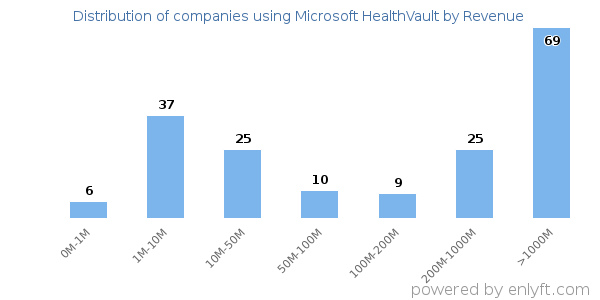Companies using Microsoft HealthVault
We have data on 144 companies that use Microsoft HealthVault. The companies using Microsoft HealthVault are most often found in United States and in the Information Technology and Services industry. Microsoft HealthVault is most often used by companies with >10000 employees and >1000M dollars in revenue. Our data for Microsoft HealthVault usage goes back as far as 7 years and 7 months.
Who uses Microsoft HealthVault?
| Company | EPAM Systems Inc |
| Website | epam.com |
| Country | United States |
| Revenue | >1000M |
| Company Size | >10000 |
| Company | SAP SE |
| Website | sap.com |
| Country | United States |
| Revenue | >1000M |
| Company Size | >10000 |
| Company | Accenture PLC |
| Website | accenture.com |
| Country | Ireland |
| Revenue | >1000M |
| Company Size | >10000 |
| Company | Cognizant Technology Solutions Corp |
| Website | cognizant.com |
| Country | United States |
| Revenue | >1000M |
| Company Size | >10000 |
| Company | Infosys Ltd |
| Website | infosys.com |
| Country | India |
| Revenue | >1000M |
| Company Size | >10000 |
| Company | Website | Country | Revenue | Company Size |
|---|---|---|---|---|
| EPAM Systems Inc | epam.com | United States | >1000M | >10000 |
| SAP SE | sap.com | United States | >1000M | >10000 |
| Accenture PLC | accenture.com | Ireland | >1000M | >10000 |
| Cognizant Technology Solutions Corp | cognizant.com | United States | >1000M | >10000 |
| Infosys Ltd | infosys.com | India | >1000M | >10000 |
Target Microsoft HealthVault customers to accomplish your sales and marketing goals.
Microsoft HealthVault Market Share and Competitors in Electronic Health Record
We use the best indexing techniques combined with advanced data science to monitor the market share of over 15,000 technology products, including Electronic Health Record. By scanning billions of public documents, we are able to collect deep insights on every company, with over 100 data fields per company at an average. In the Electronic Health Record category, Microsoft HealthVault has a market share of about 0.3%. Other major and competing products in this category include:
Electronic Health Record
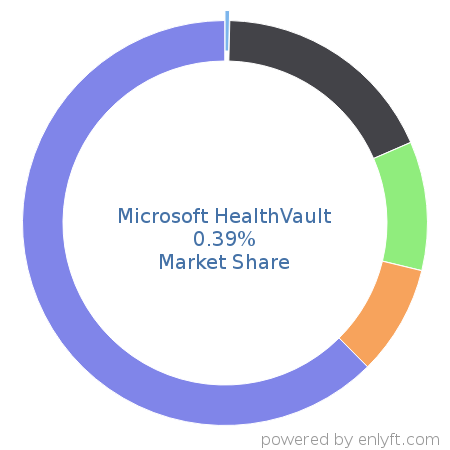

What is Microsoft HealthVault?
Microsoft HealthVault is a platform for businesses and consumers to store personal health information - and then generate insights from it.
Top Industries that use Microsoft HealthVault
Looking at Microsoft HealthVault customers by industry, we find that Information Technology and Services (21%), Hospital & Health Care (17%), Computer Software (13%) and Higher Education (9%) are the largest segments.
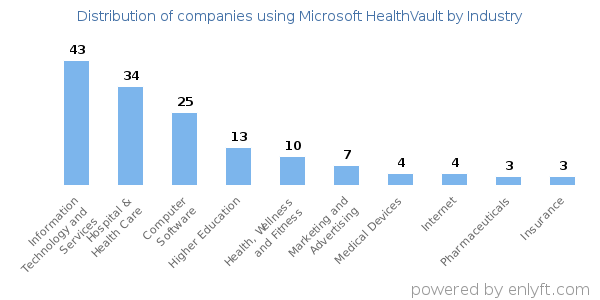
Top Countries that use Microsoft HealthVault
73% of Microsoft HealthVault customers are in United States and 7% are in India.
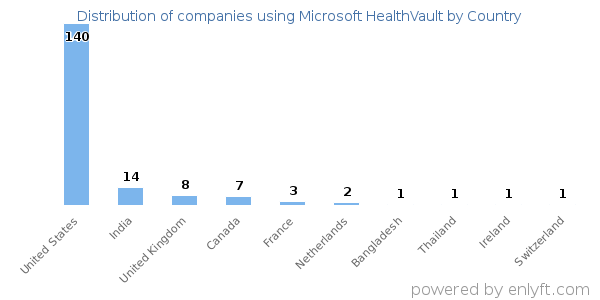
Distribution of companies that use Microsoft HealthVault based on company size (Employees)
Of all the customers that are using Microsoft HealthVault, a majority (51%) are large (>1000 employees), 20% are small (<50 employees) and 22% are medium-sized.
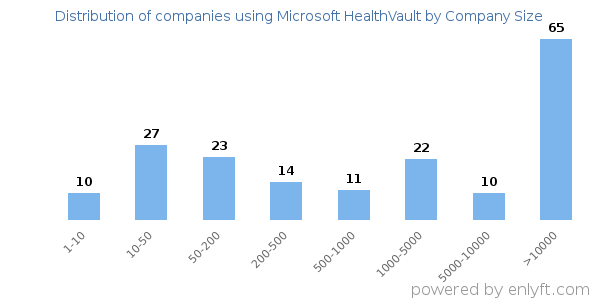
Distribution of companies that use Microsoft HealthVault based on company size (Revenue)
Of all the customers that are using Microsoft HealthVault, 32% are small (<$50M), 6% are medium-sized and 49% are large (>$1000M).
